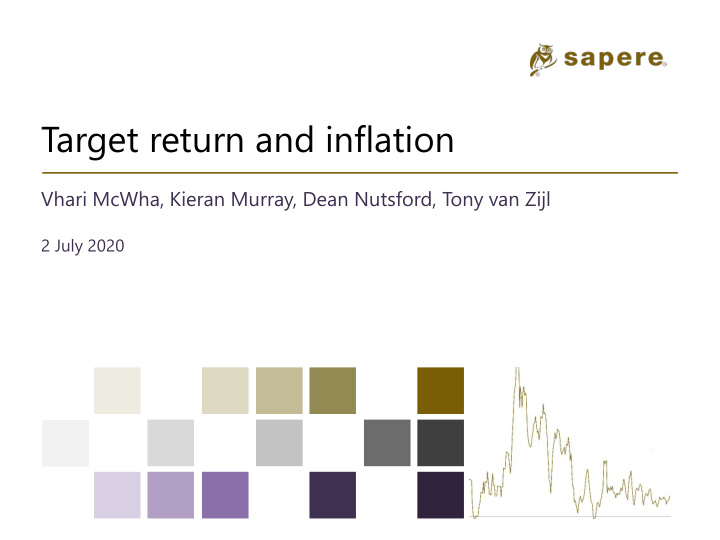



Target return and inflation Vhari McWha, Kieran Murray, Dean Nutsford, Tony van Zijl 2 July 2020
Our report • The AER asked us to consider: • Does the regulatory framework successfully deliver the current target—a real rate of return outcome? • Should the AER instead target a nominal or hybrid return? • Our preliminary conclusions are: • Yes, to the 1 st question • No, to the 2 nd question • This presentation provides an overview of our reasoning. www.thinkSapere.com 2
Analysis framed by the NEO and NGO • Our analysis starts with national electricity and gas objectives (NEO and NGO)— promoting efficient investment and operation in the long-term interests of consumers. • Investors in long-lived assets would expect real returns on capital ex ante, and that they can realize these returns ex post. • If PV of regulated revenue equals PV of costs (including return on capital), consumers pay no more than is necessary to attract efficient investment. www.thinkSapere.com 3
AER approach meets regulatory objectives The AER targets a real rate of return on capital. • The real rate of return is achieved through: • setting net ARR plus the AER’s estimate of the revaluation • gain equal to the nominal return on capital plus the return of capital; substituting outturn (lagged) inflation for expected • inflation in the annual price adjustment process revaluing service provider’s RAB using outturn inflation. • The AER approach delivers the intended real total return and • compensates for outturn inflation (deviation in 1 st year of RP). This result is achieved regardless of whether outturn inflation • is above or below the AER forecast of inflation. www.thinkSapere.com 4
Returns to equity • The realised real rate of return on equity varies in the same direction as inflation outturns: • if outturn inflation is lower than expected, the realised real RoR on equity will be lower than expected; • if outturn inflation is higher than expected, the realised real RoR on equity will be higher than the expected. • Negative cash returns to equity may occur with a low allowed nominal RoR on equity and/or high leverage. • If outturn inflation is low relative to expected inflation, the total nominal rate of return on capital may be less than interest payments. NB: The intended real total return on capital will be achieved. www.thinkSapere.com 5
We consider two hybrids • Including interest on debt as an expense in setting the ARR— would make no difference to the cash rate of return on equity; therefore would not address the concern raised by stakeholders. • Decomposing the expected revaluation gain into a revaluation gain for equity holders and an expense in setting the ARR— would shift the regulatory regime from targeting a total real RoR to targeting a real RoR on equity; would intervene in the capital structure decision and result in a less efficient allocation of the risk of financing decisions. www.thinkSapere.com 6
AER should continue to target total real returns • We conclude that the AER should continue to target a total real return—that this approach better meets the NEO and NGO. • We note that the sustained fall in inflation expectations imply a negative cashflow return on equity for a benchmark efficient entity regardless of the inflation outturn. • We suggest that the AER consider whether a projected negative cash return on equity might indicate an underlying inconsistency in one or more inputs into its estimate of WACC and expected inflation. www.thinkSapere.com 7
Kieran Murray independence, integrity and objectivity
Recommend
More recommend